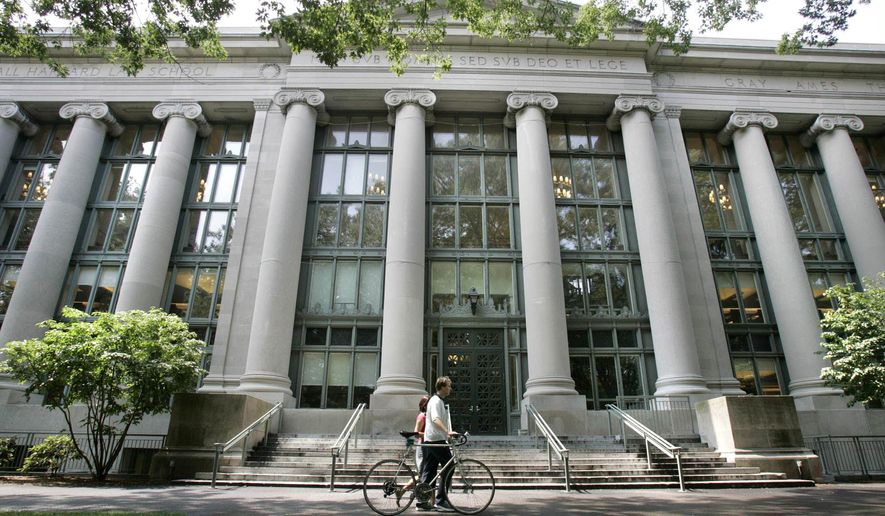Harvard University “significantly disadvantages” Asian-American applicants in its admissions policies, the Justice Department said Thursday, weighing in on one of the top affirmative action fights of the decade.
Government attorneys filed a statement of interest in an ongoing federal case in Massachusetts, saying Harvard attempts to manufacture a specific racial balance in its student body, running afoul of anti-discrimination rules.
The Justice Department had already announced a civil rights investigation of Harvard’s policies but said Thursday that a judge should hear out the Asian students’ legal challenge, too.
“No American should be denied admission to school because of their race,” Attorney General Jeff Sessions said in a statement. “As a recipient of taxpayer dollars, Harvard has a responsibility to conduct its admissions policy without racial discrimination by using meaningful admissions criteria that meet lawful requirements.”
Harvard says its policies are being misconstrued and has vigorously fought the court challenge.
But the Justice Department says there is “compelling evidence” that the policies work to disadvantage a specific race.
The department lent its support to a 2014 legal challenge by Students for Fair Admissions, a nonprofit group founded by Edward Blum, a longtime opponent of affirmative action. It said Harvard uses “racial balancing” as part of its admissions formula.
The government says it has a vested interest in the case because Harvard receives millions of dollars in taxpayer funding.
“With every taxpayer dollar that it accepts, Harvard promises not to discriminate ’on the ground of race, color, or national origin’ in ’any program or activity receiving federal financial assistance,’” the government said in its 37-page filing. “Nonetheless, Harvard acknowledges that it voluntarily uses race as a factor in deciding whether to offer certain young adults admission to, and the substantial educational benefits of, its elite institution.”
Harvard uses a “personal rating” that includes subjective factors including “likability” and whether someone is a “good person” with “human qualities,” according to court documents. The school has admitted that, on average, it has ranked Asian-American applications lower on these qualities, the Justice Department said.
Students for Fair Admissions told the court that an Asian-American male with a 25 percent chance of admission would have a 35 percent chance if he were white, a 75 percent chance if he were Hispanic and be nearly a shoo-in at 95 percent if he were black, the group calculates.
Put another way, Asian-Americans should account for more than 43 percent of the students admitted based on academic standards, the student group says. Instead, the number was 18.7 percent in 2017, according to the Students for Fair Admissions lawsuit.
Harvard says its class of 2021 is 14.6 percent black, 22.2 percent Asian-American, 11.6 percent Hispanic, and 2.5 percent American Indian or Pacific Islander — reportedly the first majority-minority class in its history. That breakdown was of U.S. students only and doesn’t take into account the 12 percent of the class that represent international students.
The Justice Department says Harvard hasn’t explained how it weighs race versus other factors in its admissions. The department said that is a requirement under the framework the Supreme Court has laid out for legal affirmative action programs.
Harvard has asked the judge to dismiss the lawsuit and says Students for Fair Admissions paints “a dangerously inaccurate” picture of its admissions process, which also includes personal essays and teacher recommendations.
The school on Thursday said the Justice Department is “recycling the same misleading and hollow arguments that prove nothing more than the emptiness of the case against Harvard.”
“Harvard College does not discriminate against applications from any group in its admissions process,” the university said in a statement, adding that it will “vigorously defend the right of Harvard and other universities to seek the education benefits that come from a class that is diverse on multiple dimensions.”
The Supreme Court has tightened the reins over the years on what sorts of affirmative action are legal, ruling out broad approaches such as quotas. But in a 2016 case the justices did approve a program at the University of Texas that took into account “student body diversity.”
But that ruling’s application to other programs is hotly debated in legal circles. The Trump administration in July revoked Obama-era guidance that said schools could consider race in admissions.
Thursday’s intervention by the Justice Department, meanwhile, sparked nine organizations to file papers in support of Harvard.
Among the organizations that filed amicus briefs include the American Civil Liberties Union, the Coalition for a Diverse Harvard and the Asian American Legal Defense and Education Fund.
In a statement, the ACLU said the Trump administration’s support for “race blind” policies are “insufficient to achieve meaningful diversity, given the reality of historic and continuing racial discrimination in this country.”
The Asian American Legal Defense and Education Fund defended Harvard by arguing that the lawsuit ignores “the many benefits of diversity that accrue to Asian Americans.”
Harvard “considers race and ethnic origin on an individualized basis within the context of a student’s entire application,” the group also wrote. “This kind of individualized treatment thwarts the harmful ’model minority’ myth that masks vast diversity within the Asian American community.”
In June, both sides filed motions for summary judgment, seeking to head off a trial scheduled for October in a Massachusetts federal court. The Justice Department’s motion asks the court to deny Harvard’s motion for summary judgment.
• Jeff Mordock can be reached at jmordock@washingtontimes.com.




Please read our comment policy before commenting.